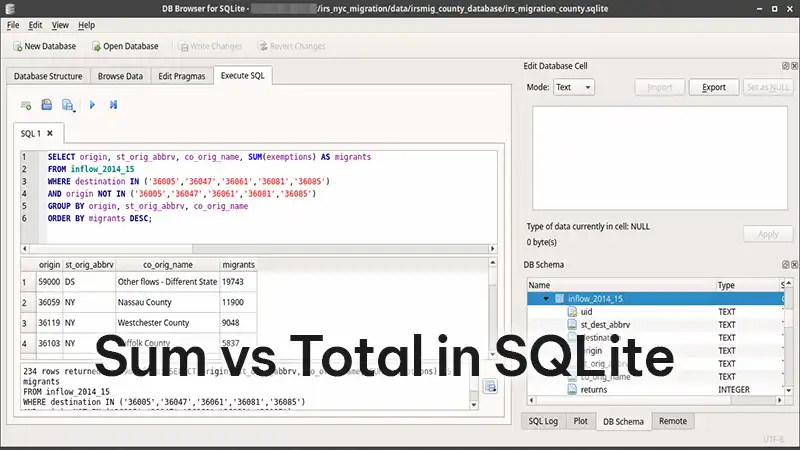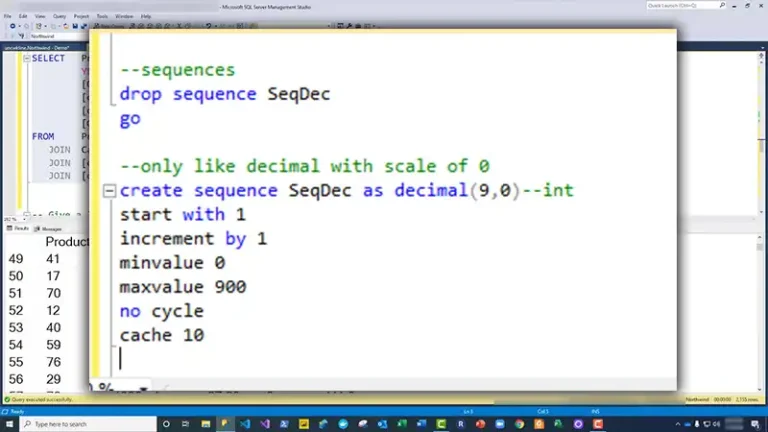Sum vs Total in SQLite | What’s the Difference?
In SQLite, the sum() and total() aggregate functions are commonly used for calculating the sum of values in a group. While these functions may appear to serve the same purpose at first glance, they harbor subtle distinctions that play a pivotal role in ensuring precise data manipulation and analysis.
Understanding these nuances is essential for harnessing the full potential of SQLite’s aggregation capabilities. So, let’s explore the intricacies that set `sum()` and `total()` apart.

What Is Sum() in SQLite?
The sum() function computes the sum of all non-NULL values within a group. If there are no non-NULL input rows, sum() returns NULL. However, it’s essential to note that if all inputs are integers or NULL, and an integer overflow occurs during computation, an “integer overflow” exception is thrown.
On the other hand, if any prior input was a floating-point value, no overflow error is raised. When dealing with floating-point values, users should exercise caution. Differences in magnitude among the values can lead to imprecise results due to the nature of IEEE 754 floating-point approximations.

For precise summation of floating-point numbers, the decimal_sum(X) aggregate, available as a loadable extension, provides an exact answer, albeit with increased CPU and memory usage.
Total(): A Convenient Alternative
The total() function serves as a workaround for the design issue in the SQL standard where sum() returns NULL when there are no non-NULL input rows. Unlike sum(), total() always returns a floating-point value, and it returns 0.0 if there are no non-NULL input rows.
One notable advantage of total() is its resilience against integer overflow exceptions. It never throws an integer overflow, regardless of the input values.
What Is the Difference Between Sum and Total in SQLite?
Here’s a table illustrating the differences between the sum() and total() aggregate functions in SQLite:
| Scenario | sum() Output | total() Output |
| Non-NULL values only | Sum of values | Sum of values |
| All NULL values | NULL | 0.0 |
| All integers or NULL with integer overflow | “Integer overflow” | 0.0 |
| All integers or NULL without integer overflow | Sum of integers | 0.0 |
| Mixed integers and floating-point numbers | Floating-point sum | Floating-point sum |
| Extreme values exceeding floating-point limits | +Infinity or -Infinity | +Infinity or -Infinity or NULL |
Example Usage
Consider the following example to illustrate the behavior of sum() and total():
CREATE TABLE sales(amount REAL);
INSERT INTO sales VALUES(100.5),(200.75),(150.25),(NULL),(75.0);
SELECT sum(amount), total(amount) FROM sales;In this scenario, sum(amount) returns the sum of non-NULL values, while total(amount) returns the total sum, including NULL values.
Handling Extreme Values
SQLite accommodates scenarios where the sum of inputs exceeds the limits of IEEE 754 floating-point representation. In such cases, a result of +Infinity or -Infinity may be returned. However, if the function cannot determine the correct result due to conflicting large values, it returns NULL.
Frequently Asked Questions
When should I use decimal_sum(X) instead of sum() for floating-point values?
Use decimal_sum(X) when precise summation of floating-point numbers is required, despite the additional CPU and memory usage.
Which can handle extreme values in SQLite, sum() or total()?
Both functions can handle extreme values, but they may produce different results. Depending on the input, sum() or total() may return +Infinity, -Infinity, or NULL if unable to determine the correct result.
Conclusion
Understanding the distinctions between sum() and total() in SQLite is crucial for accurate data aggregation and analysis. By utilizing these aggregate functions effectively, you can derive meaningful insights from your datasets. We encourage you to experiment with these functions and share your experiences for further discussion. Happy querying!






